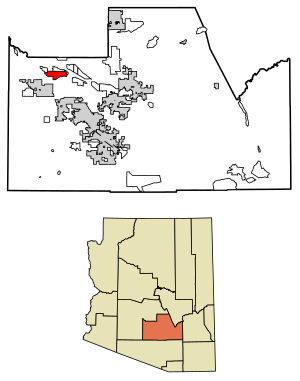Casa Blanca, Arizona facts for kids
Quick facts for kids
Casa Blanca, Arizona
|
|
|---|---|

Location of Casa Blanca in Pinal County, Arizona.
|
|
| Country | United States |
| State | Arizona |
| County | Pinal |
| Area | |
| • Total | 15.79 sq mi (40.91 km2) |
| • Land | 15.79 sq mi (40.91 km2) |
| • Water | 0.00 sq mi (0.00 km2) |
| Population
(2020)
|
|
| • Total | 1,727 |
| • Density | 109.34/sq mi (42.22/km2) |
| Time zone | UTC-7 (MST (no DST)) |
| ZIP code |
85121
|
| Area code(s) | 520 |
| FIPS code | 04-10460 |
Casa Blanca is a special kind of community called a census-designated place (CDP). It is located in Pinal County, Arizona, in the Gila River Indian Community. In 2010, about 1,388 people lived there.
Contents
History of Casa Blanca
Early Years and American Travelers
Casa Blanca was once known as La Tierra Amontonada, which means "The Land Piled Up." This name came from an old Hohokam ruin mound nearby. It was one of the Pima Villages along the Gila River. At that time, this area was part of Sonora, Mexico.
In 1846, an American group led by Stephen W. Kearny found the village. Later, many Americans passed through Casa Blanca on their way to California during the California Gold Rush. They used a route called the Southern Emigrant Trail.
After the Gadsden Purchase, the Pima Villages became part of the New Mexico Territory. In 1857, the San Antonio-San Diego Mail Line, an early mail service, started passing through the village.
Life in the Pima Villages
In 1858, a count of the Pima and Maricopa people was done. In Casa Blanca, there were 535 Pima people, including 110 warriors. Their leader was named Chelan. The next year, another count showed 491 Pima people. They had 30 cattle and 46 horses. By 1860, the census showed 323 Pima people. They owned 164 horses and 102 cattle. About 59 farmers worked on 587 acres of land.
Casa Blanca also became a stop for the Butterfield Overland Mail in 1858. This was a stagecoach service that delivered mail and passengers. The station was near the old ruin mound.
Silas St. John was the agent for the mail station. He also became a special agent for the Pima and Maricopa Indians. In 1859, he built buildings for the Indian Agency in the village. These included a blacksmith shop and an office.
In 1860, about fifteen European Americans lived in Casa Blanca. They were part of a business run by Ammi M. White. White and his partners set up a trading post. They took over the buildings that St. John had used for the Indian agency.
White's Mill and the Civil War
In 1861, White's Mill was built in Casa Blanca. It helped the Pima farmers turn their grain into flour. When the American Civil War began, Ammi White started collecting flour and food at the mill. This food was for the California Column, a group of Union soldiers.
However, a group of Confederate Army soldiers called the Arizona Rangers attacked the mill. They were led by Captain Sherod Hunter. They destroyed the mill's machines and took the flour and food. They also captured Ammi White. Later, they tricked and captured Union Army Captain William McCleave and his soldiers who came to visit the mill.
When the California Column arrived, they had to wait for more food. So, they built Fort Barrett around the mill to protect their supplies. After the Union soldiers captured Tucson, the fort was mostly left empty.
Ammi White was later set free. He returned to rebuild his mill. With more grain from Pima farmers, the mill helped feed the Union Army and local people during the rest of the war. White sold the mill in 1867. A flood destroyed it in September 1868. The machinery was later moved to Adamsville.
Population Information
| Historical population | |||
|---|---|---|---|
| Census | Pop. | %± | |
| 2020 | 1,727 | — | |
| U.S. Decennial Census | |||
In 2010, there were 1,388 people living in Casa Blanca. Most of the people (96.0%) were Native American. A small number were White (1.0%), Black (0.3%), or Asian (0.1%). About 13.04% of the population were Hispanic or Latino.
See also
 In Spanish: Casa Blanca (Arizona) para niños
In Spanish: Casa Blanca (Arizona) para niños


